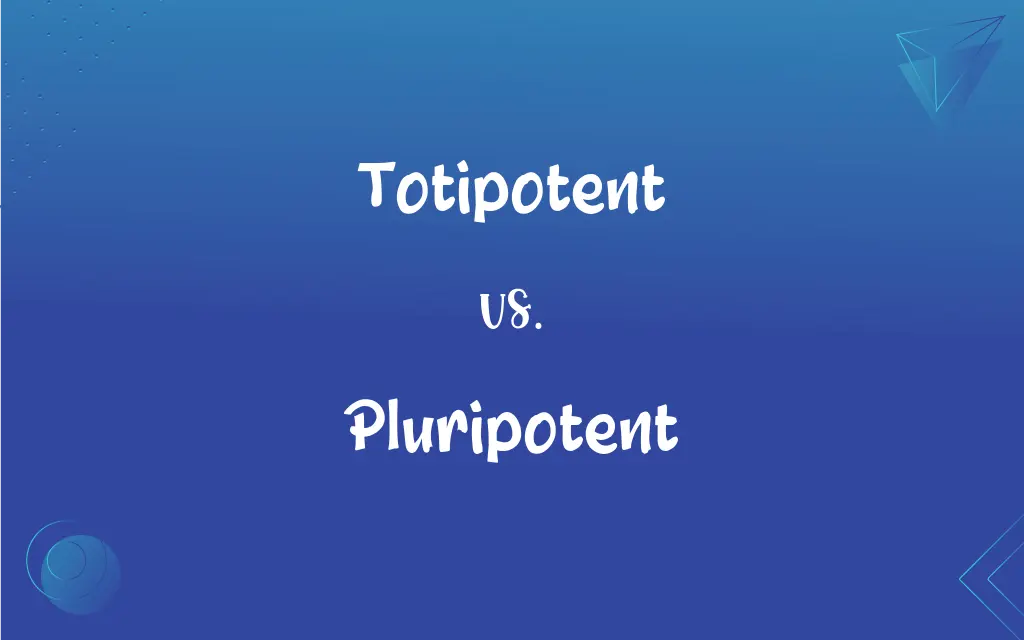Totipotent vs. Pluripotent: What's the Difference?
Edited by Aimie Carlson || By Harlon Moss || Published on January 4, 2024
Totipotent are cells that can develop into any cell type in the body, including extraembryonic or placental cells. Pluripotent are cells that can develop into almost any cell type in the body, excluding extraembryonic or placental cells.

Key Differences
Totipotency represents the cell's ability to differentiate into all cell types, including embryonic and extraembryonic tissues. Pluripotency refers to the cell's capacity to differentiate into nearly all cell types, specifically the three germ layers: endoderm, mesoderm, and ectoderm, but not extraembryonic tissues.
In the context of developmental biology, totipotent cells have the highest differentiation potential, capable of creating a complete organism. In contrast, pluripotent cells, while remarkably versatile, cannot form an entire organism independently.
Totipotent cells are present only in the early stages of embryonic development, such as the zygote and early blastomeres. Pluripotent cells are derived from the inner cell mass of the blastocyst and are the foundation for the various cell types in the body.
The key difference lies in their regenerative capacity; totipotent cells can regenerate a whole organism, essential in cloning processes. Pluripotent cells, while adaptable, are limited to generating cells of the body's various tissues and organs.
Stem cell research heavily relies on both types. Totipotent cells provide insights into early embryonic development, while pluripotent cells are crucial for understanding organ development and potential therapeutic applications.
ADVERTISEMENT
Comparison Chart
Cell Type Development
Can develop into any cell type, including extraembryonic
Can develop into almost any cell type, excluding extraembryonic
Potential in Embryogenesis
Can form a complete organism
Can form nearly all tissues of an organism
Presence in Development
Found in early embryonic stages
Found in the blastocyst stage
Application in Research
Used for understanding early development and cloning
Used in regenerative medicine and tissue repair
Regenerative Capacity
Can regenerate an entire organism
Limited to generating specific tissues or organs
ADVERTISEMENT
Totipotent and Pluripotent Definitions
Totipotent
Totipotent cells have the capacity to form all embryonic and extraembryonic cell types.
In cloning, totipotent cells are essential for generating a new organism.
Pluripotent
Pluripotent cells have the potential to form the three germ layers.
Pluripotent stem cells can develop into muscle, nerve, or skin cells.
Totipotent
Totipotent cells can differentiate into all types of cells in an organism.
The zygote, a totipotent cell, eventually develops into every cell type in the human body.
Pluripotent
Pluripotent cells are derived from the inner cell mass of the blastocyst.
In research, pluripotent cells are used to study disease mechanisms.
Totipotent
Totipotent cells possess the highest degree of developmental potential.
Totipotent cells in early embryos can create both the placenta and the baby.
Pluripotent
Pluripotent cells are key in regenerative medicine and tissue engineering.
Pluripotent cells hold the promise of repairing damaged organs.
Totipotent
Totipotency is the ability of a cell to develop into a complete organism.
Scientists study totipotent cells to understand the early stages of human development.
Pluripotent
Pluripotent cells can give rise to multiple, but not all, cell types in an organism.
Embryonic stem cells are pluripotent and can differentiate into various tissues.
Totipotent
Totipotent cells are foundational in the earliest stages of embryonic development.
A totipotent stem cell has the potential to create an entire individual from scratch.
Pluripotent
Pluripotent stem cells exclude the potential to form extraembryonic tissues.
Unlike totipotent cells, pluripotent cells cannot create placental tissue.
Totipotent
Relating to a cell, especially a fertilized egg, that is capable of differentiating into an unlimited number of specialized cell types.
Pluripotent
Relating to or being a cell that is capable of differentiating into cells of any type of tissue except placental tissue.
Totipotent
(biology) Exhibiting totipotency
Pluripotent
(biology) Able to develop into more than one mature cell or tissue type, but not all.
Totipotent
Having the ability to give rise to unlike cells;
Embryonic stem cells are totipotent
FAQs
Can totipotent cells create a whole organism?
Yes, they have the capacity to form a complete organism.
What does pluripotent mean?
The ability of a cell to develop into almost any cell type in the body, except for placental cells.
Where do pluripotent cells originate?
From the inner cell mass of the blastocyst.
What is the significance of pluripotent cells in medicine?
They are crucial in regenerative medicine and tissue engineering.
Do totipotent cells have limitations?
They are limited in availability, existing only in early embryonic stages.
Are pluripotent cells capable of forming an entire organism?
No, they can't form an entire organism but can differentiate into nearly all cell types.
Can totipotent cells differentiate into placental cells?
Yes, they can form both embryonic and extraembryonic tissues.
Are all embryonic cells totipotent?
Only cells in the very early stages of embryonic development are totipotent.
What are the limitations of pluripotent cells?
They cannot form extraembryonic tissues like the placenta.
What is totipotency?
The ability of a cell to develop into any type of cell in an organism, including placental cells.
Where are totipotent cells found?
In the early stages of embryonic development, like the zygote.
How are totipotent cells used in research?
They are used to study early embryonic development and in cloning.
Can pluripotent cells create placental cells?
No, pluripotent cells cannot form extraembryonic tissues.
Are adult stem cells pluripotent?
No, adult stem cells are typically multipotent, not pluripotent.
Why are pluripotent cells important for therapy?
They can potentially be used to repair or replace damaged tissues and organs.
Do totipotent cells have a role in cloning?
Yes, they are essential in cloning as they can develop into a whole organism.
How do pluripotent cells contribute to disease research?
They help in modeling diseases and testing new treatments.
What makes totipotent cells unique?
Their ability to give rise to a complete organism, including placental cells.
Can pluripotent cells become totipotent?
No, once cells have passed the totipotent stage, they cannot revert back.
Are totipotent cells present in adults?
No, they are only present in the earliest stages of embryonic development.
About Author
Written by
Harlon MossHarlon is a seasoned quality moderator and accomplished content writer for Difference Wiki. An alumnus of the prestigious University of California, he earned his degree in Computer Science. Leveraging his academic background, Harlon brings a meticulous and informed perspective to his work, ensuring content accuracy and excellence.
Edited by
Aimie CarlsonAimie Carlson, holding a master's degree in English literature, is a fervent English language enthusiast. She lends her writing talents to Difference Wiki, a prominent website that specializes in comparisons, offering readers insightful analyses that both captivate and inform.







































































